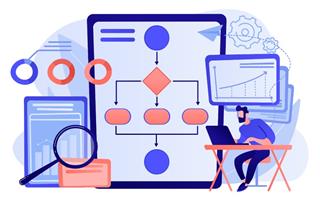How can you make automation work for you, your team and your organisation? Ruth Bentley from LAKE shares some ideas on implementing new systems and getting the best out of them.

Automation is an emotive word. It conjures up images of robots and the dehumanisation of work.
But this image is wrong. In the context of finance automation, however, the reality is quite the opposite.
Finance automation can be a saviour rather than something to be feared. For instance, if management reports can be generated quickly and easily, is that not a good thing?
Or if your charity can save money through more effective and efficient procurement, is that not a good thing?
Overcoming the fear of change
Charities can sometimes be a bit frightened of automation, perhaps because they are concerned about the impact proposed changes may have on their colleagues.
There are a couple of reasons why I believe automation should not be feared. Firstly, expectations are rising. Purchase-to-Pay (or P2P for short) is a good example.
At one time this kind of system was the exception, now it’s the norm. These days, almost every finance transformation project we deliver includes a requirement for streamlined P2P processes. And this ‘new normal’ filters down to everyone eventually. It is expected that it will happen.
Secondly, automation should be presented as positive. Change that contributes to the furtherance of the aims of the charity must be a good thing, after all. If change can be presented in that light, your colleagues will most likely agree and work hard themselves to help support the initiative.
The making of a successful project
Keeping things simple and focused improves your chances of a successful project. Automation should be about adding value, not putting clever processes in place just because you can. This should always be at the forefront of a project, especially in people-centric-organisations such as charities.
Introducing automation for the sake of it, or making things more complex than they need to be can end up working against you. For example, implementing an online approval system for purchasing is something that can save a great deal of time and money when used correctly. But to work, it needs the support of everybody.
That’s why it’s important that you don’t overcomplicate the system. It needs to be easy to use otherwise you might find your initiative is undermined by the very people that you are relying on to support it.
Similarly, don’t measure the value of your new information system by the amount of data it generates. Data on its own doesn’t help you; it’s making better decisions that helps you.
So, again, focus on value. Think about the decisions the information user needs to make and work back from there. Answer the questions, ‘what specific information do they need to drive better decisions?’, and ‘how should it be presented to them to be most effective?’
Every project needs strong internal sponsorship to keep your team on board. Someone in a position of authority who cares passionately about the project. This is where the human side comes into play. You also need a project manager who can facilitate and give the project direction. But without sponsorship from the very top it can be hard to keep people accountable long enough for them to see the real benefits of the project.
Some of the most successful projects are those that demonstrate early wins. Success early on is a great way to combat any resistance that you might face when implementing a new system as it provides momentum. People are much more likely to buy into something that they can see working very early on.
And don’t assume you have to do everything in a single project. A phased approach can sometime be more effective. In the early phases you deliver success and lay the groundwork for additional change later.”
About LAKE
To find out more about LAKE and the solutions we provide, please register for one of our scheduled Not for Profit webinars or download copies of our buyers guides: